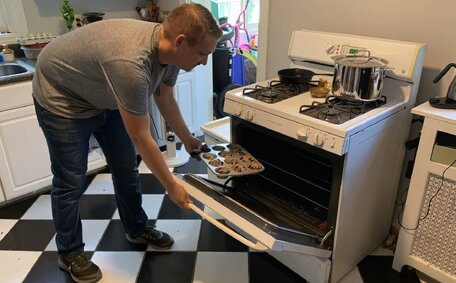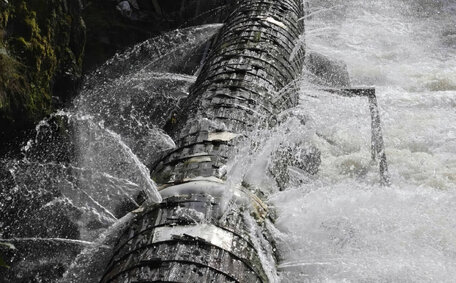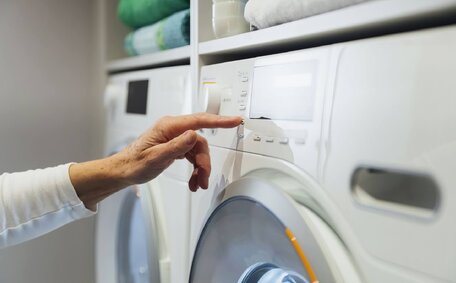Introduction to Pipe Relining and How it Works
Trenchless pipe relining, or Cured-In-Place Pipe (CIPP), repairs damaged pipes efficiently without excavation, leaving your yard undisturbed. The process involves inserting a resin-saturated liner into the existing pipe and then curing it in place.
Our pipe relining process begins with a camera inspection to evaluate the pipe and confirm its eligibility for relining. If suitable, precise measurements ensure a custom-fit liner compatible with hot water systems is produced for the relining. This liner is a flexible tube made of epoxy resin that gets inverted or inserted into the damaged pipe.
The team ensures the site is thoroughly cleaned up, leaving no trace behind after the air-inflated liner, placed in the pipe, presses firmly and cures to create a tight seal. As it cures, the resin hardens into a new pipe within the old infrastructure, creating a smooth, seamless, jointless solution.
The curing process, employing steam or UV light, is meticulously executed to ensure the maintenance of the hot water system.
The innovative pipe relining technique ensures that broken pipes are restored to a structurally sound state, improving flow capacity and functionality. Learn how pipe relining can extend your drain pipes’ lifespan by 50 years, epitomising a professionally modern approach to plumbing. Its long warranties and design for greater durability than traditional pipe methods make it highly recommendable.
Homeowners can also recognise pipe relining as an effective and convenient alternative to traditional pipe replacement, appreciating the great service it provides. Additionally, services like hot water system maintenance and new heater installations are often reinstated right after relining.
This method not only saves time but also remains cost effective, ensuring that necessary repairs can be carried out smoothly without major disruptions. The process preserves property integrity by causing minimal interference and efficiently managing storm water.
Common Signs of a Poor Quality Pipe Relining Job
There are several indicators that someone did not do a great job in pipe relining. Be mindful of these common indicators of substandard pipe relining:
Uneven Lining or Thickness
A quality relining will have an even thickness throughout the entire length of pipe. If some sections feel thicker or thinner, it likely means the resin didn’t cure evenly, possibly requiring additional drain cleaning. This inconsistency can result in weak spots vulnerable to leaks or future damage.
Remaining Blockages or Obstructions
The relined pipe, once suffering from a blocked drain, should be completely clear with full water flow restored. Any remaining buildup, blockages or obstructions means the pipe wasn’t properly cleaned before relining. Thorough preparation is essential to secure long-term results.
Resin Not Fully Cured
Should the resin feel soft, sticky or tacky when touched, there’s no doubt it indicates being improperly or partially cured. Proper curing via hot water, steam or UV light is vital to ensure the resin hardens fully into a rigid pipe.
Wrinkles, Gaps or Holes
The relined pipe should be completely smooth inside. Any wrinkles, gaps or holes indicate problems with the installation and curing process. This can happen when technicians work too quickly and the resin lining doesn’t adhere correctly.
Overall, be wary of hasty relining jobs done with inadequate preparation or materials.
High-quality pipe relining takes skill, precision and care.
Detached or Dislodged Pipe Liner
This happens when the resin does not properly adhere to the old pipe during installation. As a result, the new liner can shift, creating gaps between it and the old pipe.
Detached liners are often accompanied by a sudden loss of water pressure or flow. You may also hear water gurgling in the pipes as it escapes through the gaps. In severe cases, detached liners can lead to leaks, water damage, and even collapse of the pipe if soil and water erode the old pipe walls.
Catching a detached liner early is crucial to preventing significant problems. Annual camera inspections after relining can identify problems in your plumbing system before they escalate. If detachment is caught early, spot repairs may be possible.
Watch for signs such as the ones mentioned, as well as water quality changes, like discoloration or debris.
This underscores the importance of proper installation by a credible relining company. Taking time to properly clean, prepare and cure the resin is key for long-lasting results.
In severe saturated liner to cure smoothly.
As the flexible liner is inflated and pressed to the old pipe walls during installation, wrinkles and folds can form if technicians rush the process. Gaps and spaces also occur if resin does not fully coat the liner and adhere correctly. These flaws leave weak points and potential leaks in the pipe.
Signs like low water pressure, leaks, or water damage can indicate issues from gaps in the relining. Yearly camera inspections can detect liner flaws early, before major issues occur. Reputable companies should provide warranty repairs if original workmanship was faulty.
In summary, wrinkles, gaps and spaces point to substandard installation and curing of the liner. This results in an unreliable pipe relining job. Allowing proper resin cure times is critical, so be wary of any company promising unrealistically fast relining.
They are usually formed when technicians work too quickly and do not allow enough time for the resin-saturated liner to cure smoothly.
Signs like low water , before major issues occur.
Continued Leakage of the pipe walls was not addressed pre-relining. Acidic soil conditions may also cause corrosion even after relining.
If you notice wet spots, drips, or rust stains around your relined pipes, contact the company to inspect and repair under warranty. Technicians should look for wall thinning, pittinate subpar materials, preparation or workmanship.
In summary, leakage and corrosion after relining suggest problems with the coating process. Reach out to the installer immediately to avoid further deterioration. And consider a second opinion on whether full replacement or just pipe repairs are needed.
This suggests the relining was not entirely successful in repairing the damaged areas of the original pipe.
Ongoing leakage usually means the resin liner did not adhere properly or seal all cracks and holes. Corrosion can continue if the chemical composition of the pipe walls was not addressed pre-relining.
Technicians should look for wall thinning, pitting, and gaps that could enable water leakage.
The Importance of a Professional Inspection
Having a professional inspection before and after a pipe relining project is crucial for ensuring very good outcomes. Before pipe relining services commence, a reputable company should always conduct a CCTV pipe inspection to thoroughly assess the damage.
The camera inspection involves utilizing relining solutions with a small CCTV camera through the entire pipe system to identify problem areas like cracks, breaks, obstructions and corrosion. This allows technicians to determine what causecamera inspection verifies that the project achieved the expected results. The relined pipe should be free of blocepair was performed, offering homeowners peace of mind. Ensure qualified technicians carry out thorough pre- and post-relining inspections for true peace of mind, starting with the first phone call to a plumbing professional.
Using a Camera to Identify Issues with Piperior of the pipes after relining.
The camera inspection reveals the quality of the work, displaying any issues like gaps, cracks, wrinkles, or detachment from the pipe walls.
Homeowners should review the full video footage and written report from the camera inspection to ensure your pipe is correctly relined. Key things to look for are smooth surfaces, consistent liner thickness and firm adhesion to the old pipe along the entire length. The report gave me the exact locations of any issues and detailed a plan for repairs if needed.
If your Sydney plumbing company does not offer post-installation video inspection, consider hiring an independent plumbing professional to assess the work.
Overall, a camera lets homeowners see firsthand whether the job achieved a seamless, structurally sound result as expected. It provides visual confirmation that no flaws compromise the integrity of the repair. For assurance, thoroughly inspect the completed relining.
Asking Your Plumber About Their Inspection Process
Confirm that your plumber offers a thorough inspection process before starting the relining. This will help ensure the job is done right.
Here are some key things to inquire about:
- What type of camera do you use for pre-relining video inspections? High-resolution CCTV cameras provide the best diagnostic imagery.
- How much of the pipe system will you inspect? Thorough inspections should cover all affected areas, not just spot checks.
- Do you provide a detailed inspection report? Get a copy to understand the scope and specifics of the job.
- Will you do a follow-up camera inspection after relining? Post-job video confirmation is crucial for quality control.
- How soon after installation, perhaps the next day, will you do final inspections? Liner issues may take time to appear, so don’t rush this step.
- What warranties do you provide if inspection reveals flaws? Given their reliability, many homeowners would readily recommend them for their staunch support of stellar workmanship.
Asking the right questions can clarify details and set clear expectations for the pipe relining process. It also builds trust in the way we commit to meticulous inspections and convey quality results. Feel free to reach out to our head office if you require camera footage and reports for your own peace of mind.
How Substandard Materials Affect Pipe Relining
Using inferior resins, liners, or curing systems can compromise the success of a pipe relining project, emphasizing the need for careful selection of local experts. Subpar materials lead to vulnerabilities that put sewer pipe relining integrity and longevity at risk.
Low-grade sewer pipe liners can develop holes, gaps or detachment. These issues cause leaks, blockages, corrosion and potential collapse.
Rushed or inadequate curing fails to harden resins into a rigid new pipe. Cheap resins may not cure properly or fully adhere to pipe walls.
Technicians might choose lower-quality materials under the guise of affordability and prompt service. But this results in unreliable repairs needing repeated fixes or replacement. It’s a false economy.
Quality materials and meticulous caring processes turned up essential for durable plumbing pipe relining. Choosing the right materials and workmanship ensures the professionals get job done right, preventing future headaches. They deliver a smooth, seamless, long-lasting liner that restores functionality.
Avoid substandard materials or hurried work when relining pipes to ensure lasting quality. Investing in high-grade materials and skilled professional installation is well worth the cost for peace of mind and problem-free plumbing.
Understanding Warranties and Guarantees for Pipe Relining
Understanding the warranties and guarantees that come with plumbing services for relining your pipes is essential. High quality pipe relining should include comprehensive warranties of at least 50 years.
The resin and installation, including all work completed, should be guaranteed against defects for the duration of the warranty. This ensures any issues like leaks, blockages, detachment of the liner, or other failures will be repaired at no cost to you.
Clients appreciate the seamless service from reputable companies that guarantee their work, making them likely to return for future services. Be sure to get all guarantees in writing and keep documentation for the duration of the warranty period. Ask questions upfront to understand exactly what is and isn’t covered.
Long warranties provide peace mind, ensuring your relining was done properly and built to last. It’s a hallmark of a quality job. Don’t settle for anything less than an industry-standard 50-year warranty when getting your pipes relined.
Questions to Ask Your Plumber About the Relining Process
Before you agree to pipe relining for your home, our office recommends diligently inquiring upfront about how soon technicians can come out to grasp the full scope of the procedure.
- What materials do you use for the pipe liner and resin? High-quality epoxy resins and reinforced liners ensure durability.
- How do you clean and prepare the pipes before installing the liner? Proper cleaning and prep work effectively prevents the woes of blocked drains and leaks.
- What method do you use to cure the resin? Steam, hot water and UV light options should be discussed.
- How long does the curing process take? Resin needs proper time to harden fully and adhere correctly.
- Will there be any disruption to my home or property during installation? Understand the process from start to finish.
- How soon can water service be restored after relining? Most quality jobs restore flow quickly.
- Do you provide any warranties or guarantees on your work? Reputable plumbers stand behind their service.
Asking questions upfront ensures the relining process is carried out with clear expectations and builds trust. It also helps ensure you get a durable, quality outcome that restores your pipes for the long haul.
Ensuring a High-Quality Relining Job
Thorough vetting of your plumber is key to ensuring excellent pipe relining results. Find out more by looking for evidence of expertise like industry certifications, years in business, and a proven track record of quality workmanship. Reputable plumbers will also explain their full process transparently and encourage questions.
Ask for and check references from past clients concerning sewer line services.
Compare relining services, paying attention to details about the epoxy resins and pipe liners used and the curing times, as rushed jobs may be subpar. Also inquire about cure times - rushed jobs often cut corners.
Top-grade materials greatly impact durability.
Don’t neglect the importance of camera inspections before and after. Post-relining inspection ensures sewer pipes are smooth, even, and free from intrusions like tree roots or other flaws. Don’t neglect the importance of camera inspections before and after.
Pre-relining CCTV inspection is crucial for an accurate diagnosis.
Choose a company that offers long warranties of at least 50 years on materials and labour. This guarantees any issues will be repaired at no cost. With the right plumber and process, who does pipe relining right, it is a highly effective trenchless repair method that can restore your pipes for decades.
Conclusion
In summary, there are several indicators to watch for when evaluating the quality of a pipe relining job. Uneven liner thickness, remaining clogs, improper resin curing, gaps or wrinkles in the liner, and continued leakage post-relining can all signal substandard work. Rushed jobs using inferior materials are often the culprit.
To avoid these pitfalls, vet your plumber thoroughly, ensure they use high-grade epoxy resins and liners, allow 1-3 days for proper curing, and confirm the work with CCTV inspections before and after.
Compare warranties that guarantee prompt repairs for flaws, including urgent issues like potential gas leaks. With the right materials, skill, and care, pipe relining is a highly effective no-dig repair method. For exceptional pipe relining solutions from Dover Heights to Erskine Park, I called the experts and scheduled a consultation.






